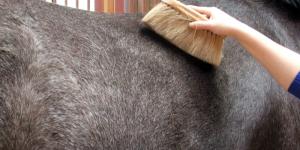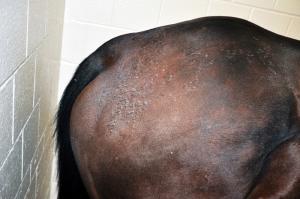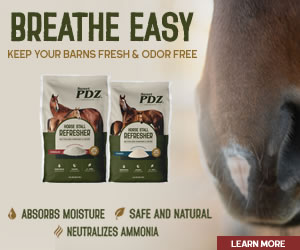Compiled By Nancy Brannon, Ph.D.
With the overabundance of rain the mid-south has had this year, veterinarian Dr. Jennifer Dunlap says that “rain rot” is an equine health problem that she has seen a lot lately. We consulted with Dr. Dunlap and others to bring you information on this timely topic.
The horse owner may observe that the hair coat on the horse’s back develops crusty scabs that peel off with clumps of hair and leave bare spots on the skin. The condition has been attributed to a fungal infection, but is actually caused by bacteria. Back in 2015, the veterinarians at Full Circle Equine Services answered a question about rain rot in our “Ask the Vet” series. Here’s what they had to say.
“When horses are out in damp, humid weather, conditions are prime for skin conditions. One of the most common is “rain rot” or infectious dermatitis. Infectious dermatitis can be a mixed fungal and bacterial infection; one bacterium in particular,Dermatophilus congolensis, is often implicated. This condition most commonly occurs over the trunk and on the hind legs, and forms deep flat scabs that may have puss underneath. Lesions on the back are often very tender. Some horses experience mild rain rot that is simply an aesthetic annoyance, but it can become severe enough that horses are uncomfortable wearing a saddle and need to be given time off until it heals.
“There are countless over the counter products and home remedies for rain rot. But I promise you’ll get the infection resolved and the skin healed quicker if you let your veterinarian be involved in treating your horse’s rain rot. Most veterinarians will prescribe some topical treatment such as antifungal/antibacterial shampoo or ointment. With the shampoo, you’ll need to throw in some good old fashioned elbow grease. Most vets agree that the scabs need to be shampooed until they loosen and can be gently picked off. Then, if using a medicated shampoo, you need to let it soak for 5-10 minutes before rinsing thoroughly. In severe cases, I also prescribe oral or injectable antibiotics. Rain rot can be contagious, so be sure to wash saddle pads and brushes after every use until the skin is cleared up.”
Read more at: http://www.fullcircleequineservice.com/article/skin/
Manna Pro answered some common myths about this disease.
Question: Does rain rot only affect horses left out in the rain for excessive periods without a blanket or run-in shed for protection?
Answer: While rain rot is a common condition in horses whose skin is frequently exposed to rain, it can occur in blanketed horses, too. Rain rot can also occur when a horse owner uses a rain sheet or older blanketing product that does not have any breathability inherent in its fabric.
The run-in shed may provide a safe haven from heat and insects, and shade from the sun’s rays, but the rest of the time a horse may simply ignore the benefit of the run-in shed. So provision of shelter will not automatically negate your horse from contracting rain rot.
Read more at: https://info.mannapro.com/equine/common-misconceptions-about-rain-rot-in-horses
Equiderma states: “The organism Dermatophilus congolensis causes rain rot. Dermatophilus congolensis is not a fungus. It is an actinomycetes, which behaves like both bacteria and fungi.
“These organisms can live in dormancy on the skin for some time, and become active with moisture, high humidity and warm temperatures. During winter it can easily develop when blanketing is prevalent. The blanket warms your horse and also creates a warm, cozy environment for dermatophiles. Both conditions are the perfect environment to grow a flourishing garden of rain rot. Zoospores germinate to produce barbed, threadlike tentacles, which penetrate into the living skin and spread in all directions. The result is an acute inflammatory reaction.”
Find moreinformation from Equiderma about rain rot at: https://equiderma.com/rain-rot-or-rain-scald/
Practical Horseman magazine published an exposé on rain rot in July 2017, in consultation with William Miller, VMD, DACVD, a veterinary dermatologist at the Cornell University College of Veterinary Medicine.
“Infection requires that the normal barriers of the skin be compromised. In an average horse, prolonged skin saturation without drying weakens the outermost layer of the skin, enabling easy infection,” Dr. Miller says. “With moisture, the organism becomes flagellated [capable of movement in the area of infection] and can spread on the animal’s body to new areas. When flagellated, the bacteria can also be transferred to another animal by insects or grooming tools.”
Rain rot is more common during wet seasons and in geographical locations with high precipitation and humidity, which foster the perfect environment for bacteria to grow.
Horses with compromised immune systems are also at a higher risk.
Because horses can be affected by numerous bacterial and fungal skin conditions, a veterinarian can scientifically confirm dermatophilosis to eliminate any confusion about how to move forward with treatment.
Because rain rot is contagious to humans and other animals, brushes, buckets and blankets that come in contact with an infected horse should be thoroughly cleaned after use and not shared with other horses. It’s also a good rule of thumb to keep an infected horse separated from other animals on the farm.
Read the full article at: https://practicalhorsemanmag.com/health-archive/beneath-the-surface-of-rain-rot
Treatment
Dr. Dunlap says that, in cool/cold rainy weather, she generally recommends keeping a lightweight, waterproof sheet on the horse to keep the moisture off. For treatment of the rain rot, she uses a dilute betadine bath days in a row to kill the cause of the rain rot. If it’s a bad case, typically she has to use a prescription strength shampoo and antibiotics.
Prevention
The best way to deal with rain rot is prevention. Regular, thorough grooming is essential – for all horses and especially for pasture kept horses. The above-mentioned article from Practical Horseman magazine includes rain rot prevention advice from professional groom Max Corcoran.
First, clean out the horse’s hooves with a hoof pick. Then groom the body starting with the top of the neck and working your way rearward. Begin with a curry comb and then follow up brushing with a medium brush and finish off with a soft brush. While you’re grooming with the brush, it’s handy to have the curry comb in the other hand to periodically clean the hair and dirt out of the brush you’re using. Make sure to brush off any mud from the legs and hooves. Have a mane and tail brush that you can use to remove mud and un-matt the mane and tail. Start at the bottom of the tail (as you would your own hair) and move upwards. Here’s where it is helpful to have a detangler product like Farnam’s Laser Sheen, Show Sheen, or Mane ‘n Tail Detangler.
If your horse is blanketed, remove blankets every few days, at least, to check over a horse’s body and skin condition. If possible, leave blankets off for a while so the skin can breathe.
US Equestrian has a great video on basic grooming with Max Corcoran at: https://www.usef.org/learning-center/videos/basic-horse-grooming.
Farnam has a horse grooming guide at: https://www.farnam.com/stable-talk/horse-grooming-guide.
Also consult the Dermatology section at Cornell University College of Veterinary Medicine at: https://www.vet.cornell.edu/hospitals/services/dermatology-0
If you do an Internet search for “rain rot,” you will find several useful articles about the disease from other sources, such as The Horse and Michigan State University Extension. As our local veterinarians recommend, the best approach is to consult your veterinarian first to get an appropriate diagnosis and treatment plan for your horse. Removing the crusty scabs and good grooming is going to be one of the components, along with an appropriate topical antifungal/antibacterial shampoo and ointment.
With the overabundance of rain the mid-south has had this year, veterinarian Dr. Jennifer Dunlap says that “rain rot” is an equine health problem that she has seen a lot lately. We consulted with Dr. Dunlap and others to bring you information on this timely topic.
The horse owner may observe that the hair coat on the horse’s back develops crusty scabs that peel off with clumps of hair and leave bare spots on the skin. The condition has been attributed to a fungal infection, but is actually caused by bacteria. Back in 2015, the veterinarians at Full Circle Equine Services answered a question about rain rot in our “Ask the Vet” series. Here’s what they had to say.
“When horses are out in damp, humid weather, conditions are prime for skin conditions. One of the most common is “rain rot” or infectious dermatitis. Infectious dermatitis can be a mixed fungal and bacterial infection; one bacterium in particular,Dermatophilus congolensis, is often implicated. This condition most commonly occurs over the trunk and on the hind legs, and forms deep flat scabs that may have puss underneath. Lesions on the back are often very tender. Some horses experience mild rain rot that is simply an aesthetic annoyance, but it can become severe enough that horses are uncomfortable wearing a saddle and need to be given time off until it heals.
“There are countless over the counter products and home remedies for rain rot. But I promise you’ll get the infection resolved and the skin healed quicker if you let your veterinarian be involved in treating your horse’s rain rot. Most veterinarians will prescribe some topical treatment such as antifungal/antibacterial shampoo or ointment. With the shampoo, you’ll need to throw in some good old fashioned elbow grease. Most vets agree that the scabs need to be shampooed until they loosen and can be gently picked off. Then, if using a medicated shampoo, you need to let it soak for 5-10 minutes before rinsing thoroughly. In severe cases, I also prescribe oral or injectable antibiotics. Rain rot can be contagious, so be sure to wash saddle pads and brushes after every use until the skin is cleared up.”
Read more at: http://www.fullcircleequineservice.com/article/skin/
Manna Pro answered some common myths about this disease.
Question: Does rain rot only affect horses left out in the rain for excessive periods without a blanket or run-in shed for protection?
Answer: While rain rot is a common condition in horses whose skin is frequently exposed to rain, it can occur in blanketed horses, too. Rain rot can also occur when a horse owner uses a rain sheet or older blanketing product that does not have any breathability inherent in its fabric.
The run-in shed may provide a safe haven from heat and insects, and shade from the sun’s rays, but the rest of the time a horse may simply ignore the benefit of the run-in shed. So provision of shelter will not automatically negate your horse from contracting rain rot.
Read more at: https://info.mannapro.com/equine/common-misconceptions-about-rain-rot-in-horses
Equiderma states: “The organism Dermatophilus congolensis causes rain rot. Dermatophilus congolensis is not a fungus. It is an actinomycetes, which behaves like both bacteria and fungi.
“These organisms can live in dormancy on the skin for some time, and become active with moisture, high humidity and warm temperatures. During winter it can easily develop when blanketing is prevalent. The blanket warms your horse and also creates a warm, cozy environment for dermatophiles. Both conditions are the perfect environment to grow a flourishing garden of rain rot. Zoospores germinate to produce barbed, threadlike tentacles, which penetrate into the living skin and spread in all directions. The result is an acute inflammatory reaction.”
Find moreinformation from Equiderma about rain rot at: https://equiderma.com/rain-rot-or-rain-scald/
Practical Horseman magazine published an exposé on rain rot in July 2017, in consultation with William Miller, VMD, DACVD, a veterinary dermatologist at the Cornell University College of Veterinary Medicine.
“Infection requires that the normal barriers of the skin be compromised. In an average horse, prolonged skin saturation without drying weakens the outermost layer of the skin, enabling easy infection,” Dr. Miller says. “With moisture, the organism becomes flagellated [capable of movement in the area of infection] and can spread on the animal’s body to new areas. When flagellated, the bacteria can also be transferred to another animal by insects or grooming tools.”
Rain rot is more common during wet seasons and in geographical locations with high precipitation and humidity, which foster the perfect environment for bacteria to grow.
Horses with compromised immune systems are also at a higher risk.
Because horses can be affected by numerous bacterial and fungal skin conditions, a veterinarian can scientifically confirm dermatophilosis to eliminate any confusion about how to move forward with treatment.
Because rain rot is contagious to humans and other animals, brushes, buckets and blankets that come in contact with an infected horse should be thoroughly cleaned after use and not shared with other horses. It’s also a good rule of thumb to keep an infected horse separated from other animals on the farm.
Read the full article at: https://practicalhorsemanmag.com/health-archive/beneath-the-surface-of-rain-rot
Treatment
Dr. Dunlap says that, in cool/cold rainy weather, she generally recommends keeping a lightweight, waterproof sheet on the horse to keep the moisture off. For treatment of the rain rot, she uses a dilute betadine bath days in a row to kill the cause of the rain rot. If it’s a bad case, typically she has to use a prescription strength shampoo and antibiotics.
Prevention
The best way to deal with rain rot is prevention. Regular, thorough grooming is essential – for all horses and especially for pasture kept horses. The above-mentioned article from Practical Horseman magazine includes rain rot prevention advice from professional groom Max Corcoran.
First, clean out the horse’s hooves with a hoof pick. Then groom the body starting with the top of the neck and working your way rearward. Begin with a curry comb and then follow up brushing with a medium brush and finish off with a soft brush. While you’re grooming with the brush, it’s handy to have the curry comb in the other hand to periodically clean the hair and dirt out of the brush you’re using. Make sure to brush off any mud from the legs and hooves. Have a mane and tail brush that you can use to remove mud and un-matt the mane and tail. Start at the bottom of the tail (as you would your own hair) and move upwards. Here’s where it is helpful to have a detangler product like Farnam’s Laser Sheen, Show Sheen, or Mane ‘n Tail Detangler.
If your horse is blanketed, remove blankets every few days, at least, to check over a horse’s body and skin condition. If possible, leave blankets off for a while so the skin can breathe.
US Equestrian has a great video on basic grooming with Max Corcoran at: https://www.usef.org/learning-center/videos/basic-horse-grooming.
Farnam has a horse grooming guide at: https://www.farnam.com/stable-talk/horse-grooming-guide.
Also consult the Dermatology section at Cornell University College of Veterinary Medicine at: https://www.vet.cornell.edu/hospitals/services/dermatology-0
If you do an Internet search for “rain rot,” you will find several useful articles about the disease from other sources, such as The Horse and Michigan State University Extension. As our local veterinarians recommend, the best approach is to consult your veterinarian first to get an appropriate diagnosis and treatment plan for your horse. Removing the crusty scabs and good grooming is going to be one of the components, along with an appropriate topical antifungal/antibacterial shampoo and ointment.










